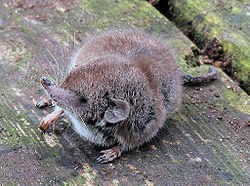| Crocidura [1] Temporal range: | |
|---|---|
 | |
| Greater white-toothed shrew, C. russula | |
| Scientific classification | |
| Kingdom: | Animalia |
| Phylum: | Chordata |
| Class: | Mammalia |
| Order: | Eulipotyphla |
| Family: | Soricidae |
| Subfamily: | Crocidurinae |
| Genus: | Crocidura Wagler, 1832 |
| Type species | |
| Sorex leucodon [2] (Hermann, 1780) | |
| Species | |
See text. | |
The genus Crocidura is one of nine genera of the shrew subfamily Crocidurinae. Members of the genus are commonly called white-toothed shrews or musk shrews, although both also apply to all of the species in the subfamily. With over 180 species, Crocidura contains the most species of any mammal genus. [3] The genus name Crocidura comes from Ancient Greek κροκύς (krokús), meaning "piece of wool", and οὐρά (ourá), meaning "tail", and thus, "woolly tail", referring to the species' tails being covered in short hairs interspersed with longer ones. [4]
Contents
They are found throughout all tropical and temperate regions of the Old World, from South Africa north to Europe, and east throughout Asia, as far east as the Malay Archipelago. One species, the possibly extinct Christmas Island shrew (C. trichura), also inhabited Christmas Island. They likely originated in Africa or Asia Minor during the Miocene, spread to Europe by the early Pliocene, and spread to eastern Asia and the Mediterranean by the Pleistocene. [5] [6]